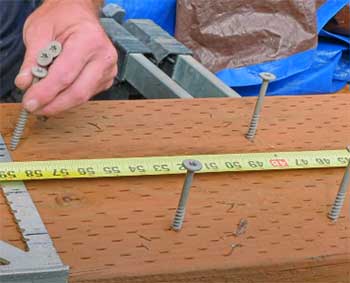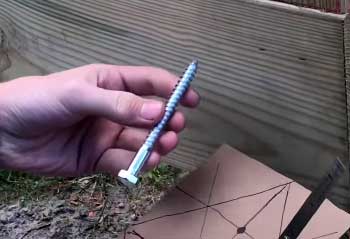Are you a professional handyperson who handles different types of construction projects? Perhaps, you have already familiar with ledger locks and lag bolts. Both are the most common items for woodworkers.
But what is the difference between ledger locks vs. lag bolts?
In this article, we will go for an in-depth comparison session to help you learn various vital attributes of both types of screws. Understanding the primary differences will enable you to choose the right one based on your project requirement.
A Brief Comparison Table
Wondering what the primary differences between these screws are? Here are the most noticeable dissimilarities between them.
| Specification | Ledger Locks | Lag Bolts |
| Material | Stronger and heat-treated hardened steel | Steel, stainless steel, or silicon bronze |
| Physical structure | thin and sharp shape | larger diameter and length |
| Drilling | Requires no pre-drilling | Needs to drill two holes |
| Strength | Super strong | Average Strength |
| Sizing options | Specific sizes and standards. | Generic sizes and standards |
| Tools required for installation | Wrench | Screwdriver |
| Installation time | Faster to install | Time-consuming to install |
| Ideal place to use | Multi-ply, Structural decking, interior and exterior remodeling, Heavy-duty framing, etc. | Heavy pieces of wood, concrete or masonry walls |
| Durability | Extremely durable | Average durability |
| Cost | Highly expensive | Affordable |
| Availability | Medium | High |
Primary Differences Between Ledger Locks And Lag Bolts
Let’s learn in-depth details about ledger locks and lag bolts by comparing them head-to-head.
- Material

Ledger locks are made from highly strong and heat-treated hardened steel. This type of screw has increased strength and abrasion-resistant properties.
They can withstand wear and tear more effectively with minimal damage effects.
In contrast, lag bolts are made from different materials such as steel, stainless steel, or silicon bronze, etc. It depends on the brand.
Nuts made from silicon bronze have impressive corrosion-resistant properties. Plus, they can handle high-heat environments effectively.
- Physical structure
Ledger locks come in a thin and sharp shape. They can go down more quickly while covering minimal space.
Contrastly, lag bolts have a wide length and diameter. You need to apply more force to put them down appropriately.
- Drilling
You don’t need to do any drilling for ledger locks. However, following the manufacturer’s guidelines to install them is crucial. Some may prefer to use the IRC instruction. But it may not always be compatible with the manufacturer’s direction.
On the other hand, drilling two holes are necessary to install lag bolts for each lag screw. One hole is for the shaft of bulky clearance, and the other one is for the threads.
Otherwise, you may notice splitting issues.
- Strength
Compared to lag bolts, ledger locks are stronger. They can hold more weight and force. This makes them compatible for use with treated lumber.
Plus, their flat head design enables them to countersink inside the wood. Ledger locks are less likely to strip since they are equipped with a star drive.
- Sizing Options

Ledger locks are available in only a few specific sizes and standards.
You can’t get too many diameters and length options.
In contrast, lag bolts come in various sizes and lengths. This gives you high flexibility to work on different types of projects.
However, most of the lag bolts lack a rated stress tolerance. You may need to search the market deeply to find more authentic options.
- Tools Required For Installation
The best tool for installing ledger locks is a wrench. Make sure to choose the right style and size. On the other hand, lag bolts are easy to install with a screwdriver.
Since it is one of the most common tools, you don’t need to be concerned about it.
- Installation Time
Since you don’t need to drill any holes before installing ledger locks, they are quicker to install. As a result, it will save your time. This comes in handy when you are handling a bulky project.
Contrastly, it is pretty time-consuming to install lag screws. After all, you need to drill two holes for each bolt. You may need to spend several hours just to drill these holes for massive construction jobs.
- Ideal Place To Use
Every bolt or nut is made for specific purposes. But a few of them may work as interchangeably. Ledger locks are ideal for using various projects such as multi-ply, structural decking, lvl fastening, interior, and exterior remodeling, heavy-duty framing, etc
On the flip side, lag bolts are ideal for heavy wood pieces, concrete or masonry walls, heavy lumber, stair repair, deck boards, wood fence panels, etc. You can even use them for any wood items that require intense loading.
- Durability
Compared to lag bolts, ledger locks are more durable. After all, they are made from more sturdy materials. Plus, They passed several tests before making them available in the market. This makes them a more reliable option.
- Cost
One of the key reasons many people prefer lag bolts is their affordability. The price of ledger locks can be at least two or three times higher than lag bolts. The overall cost may appear significant if you are handling a bulky wood project.
- Availability
There are only two or three brands available for ledger locks. After all, it has not been so long since these latest screws entered the market.
Unfortunately, you may not find them in all areas of your nearby places. Plus, not all professional repairmen keep them because they are expensive and hard to find.
In contrast, lag bolts are easy to find. You can easily find it from your nearby stores since there are dozens of brands sell these screws.
Which Screws Will Be The Best One For Your Works?
Since our working projects vary, we don’t need similar screws. Before choosing any specific bolts, you must first determine your project requirements, budget, and effectiveness.
Ledger locks appear reliable if you want more robust performance from your woodworking projects. Plus, it meets most current ICC standards and stringent engineering standards. This makes them a more reliable and safer option.
On the contrary, lag bolts are also good when you prefer a more affordable and common option. You can’t expect them to perform as reliably as ledger locks do. After all, they lack standards and may not give your wood the optimal protection you want.
Frequently Asked Questions (FAQs)
Ledger locks are used for different purposes such as multi-ply, structural decking, interior, and exterior remodeling, heavy-duty framing, etc
Ledge locks or Structural screws are a better option than lag bolts because they provide more robust and durable connections.
Yes, you can use structural screws instead of lag bolts since they have an interchangeable diameter for simple usage.
You need to use two lag bolts to attach a ledger board in a house.
Wrapping Up
Since we do woodworking projects as a long-term investment, you want to ensure you get the maximum value for your time, money, and efforts. Choosing the right-sized and length screws or bolts is crucial to successful the project.
You can pick bolt options depending on the project you will handle. But if you don’t have any budget issues and have the accessibility to get ledger locks easily, you should select this option. After all, it is more reliable and effective.
